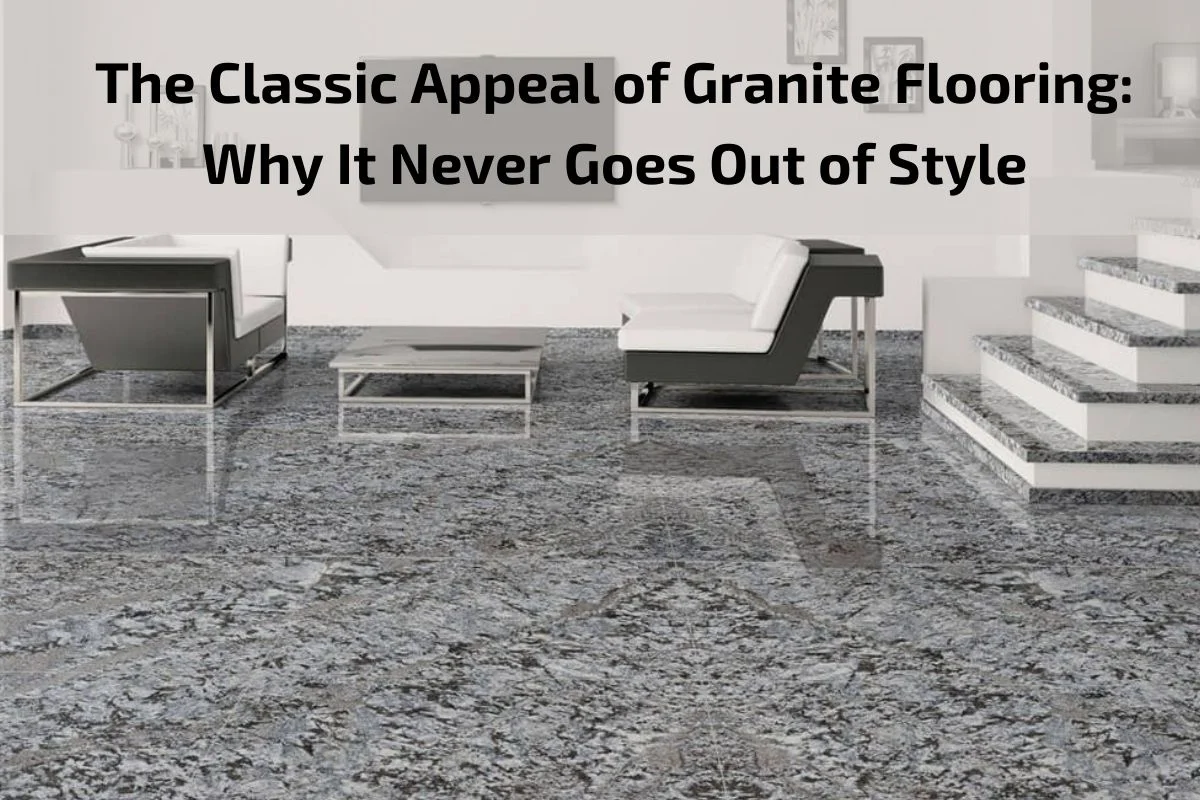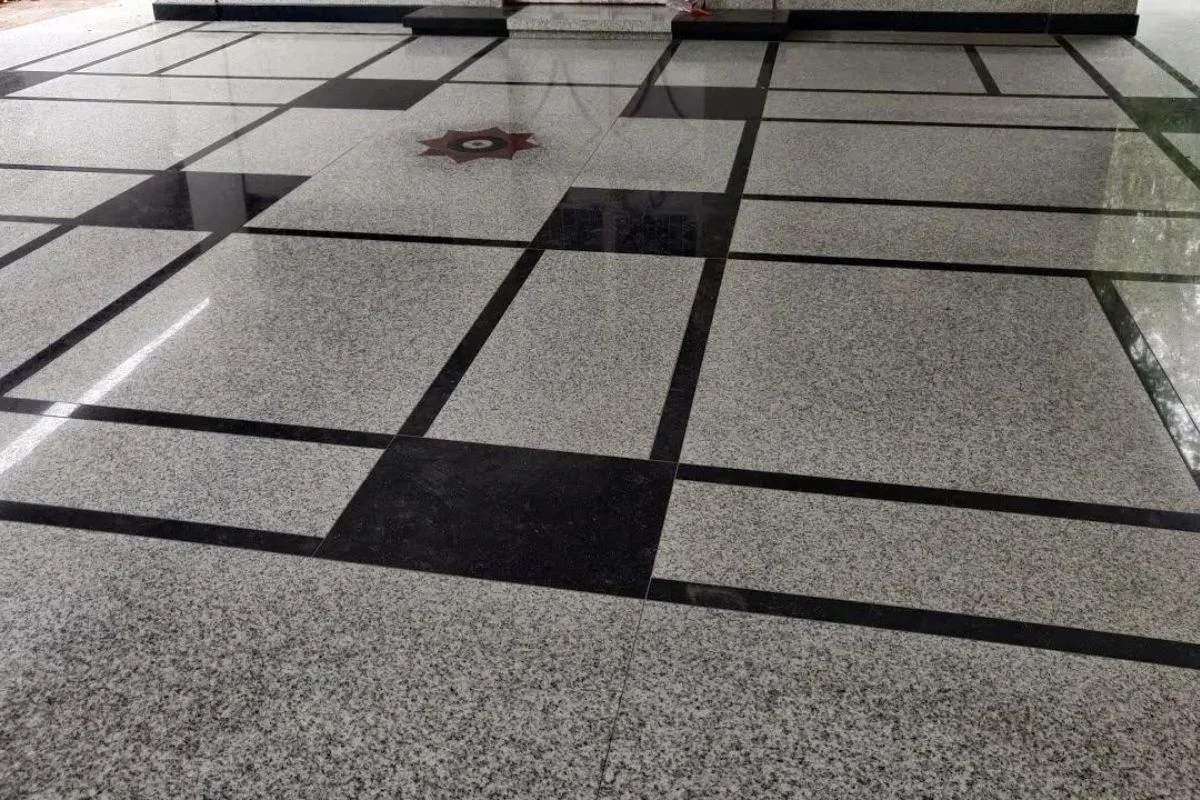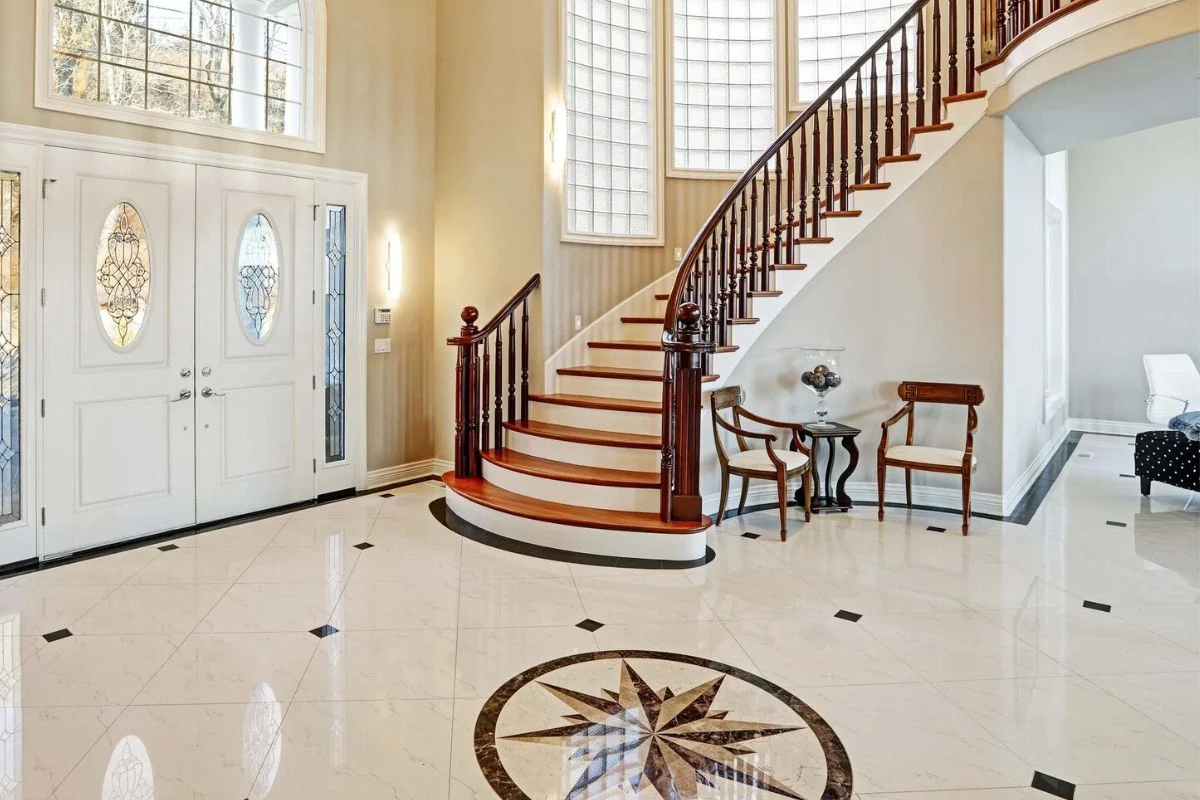
Granite flooring stands as a timeless testament to elegance and durability in the realm of interior design. With its natural beauty, unparalleled strength, and enduring appeal, granite has remained a coveted choice for homeowners, designers, and architects for centuries.
In this exploration of “The Classic Appeal of Granite Flooring: Why It Never Goes Out of Style,” we delve into the rich history, inherent characteristics, and timeless allure of granite as a flooring material. From ancient civilizations to modern-day architectural marvels, granite flooring has adorned the most prestigious spaces with its unmistakable presence.
Granite’s appeal lies in its innate ability to seamlessly blend beauty with functionality. Quarried from the depths of the earth, each slab of granite bears a unique pattern and color palette, showcasing the raw splendor of nature in every vein and hue. From the understated elegance of subtle grays to the bold richness of deep blacks and vibrant reds, granite offers a spectrum of options to suit every design aesthetic.
Beyond its aesthetic charm, granite flooring boasts unparalleled durability and longevity. Resistant to scratches, stains, heat, and moisture, granite can withstand the rigors of daily life with ease, making it an ideal choice for high-traffic areas and spaces prone to spills and accidents.
Moreover, granite’s timeless appeal transcends fleeting trends and fads, ensuring that it remains a coveted choice for generations to come. Whether adorning the floors of grand palaces, stately homes, or contemporary dwellings, granite exudes an air of sophistication and luxury that never fails to captivate the senses.
Brief overview of granite flooring
Granite flooring is a luxurious and durable option that has been cherished for centuries for its natural beauty and exceptional strength. Quarried from deep within the earth’s crust, granite is a type of igneous rock known for its unique patterns, rich colors, and enduring qualities.
Used extensively in both residential and commercial settings, granite flooring adds a touch of elegance and sophistication to any space. Its versatility allows it to complement a wide range of interior design styles, from traditional to contemporary, making it a timeless choice for flooring solutions.
Granite flooring is prized for its durability and resistance to scratches, stains, heat, and moisture, making it suitable for high-traffic areas such as kitchens, hallways, and entryways. Its natural hardness and density also contribute to its longevity, ensuring that it withstands the test of time with minimal maintenance.
Available in a variety of finishes, including polished, honed, and flamed, granite flooring offers versatility in design and aesthetic appeal. Whether you prefer the glossy sheen of polished granite or the understated elegance of honed granite, there is a finish to suit every taste and preference.
In summary, granite flooring epitomises the perfect combination of beauty and durability, making it a coveted choice for discerning homeowners and designers seeking a flooring material that exudes timeless charm and enduring quality.

Advantages and Disadvantages of Granite Flooring
Granite flooring offers numerous benefits but also comes with some considerations. Understanding both its advantages and disadvantages can help you make informed decisions when choosing flooring for your space.
Advantages:
Exceptional Durability: Granite is one of the hardest natural stones available, making it highly resistant to scratches, stains, and wear. It can withstand heavy foot traffic and is ideal for areas prone to spills and accidents.
Timeless Aesthetic Appeal: Granite flooring exudes elegance and sophistication with its natural beauty and unique patterns. Each slab of granite is one-of-a-kind, adding character and charm to any space.
Wide Range of Colors and Patterns: Granite comes in a variety of colors, ranging from earthy browns and greens to striking blacks and blues. Its intricate veining and speckled patterns offer versatility in design and allow for customization to suit different interior styles.
Heat and Moisture Resistance: Granite is naturally heat and moisture-resistant, making it suitable for use in kitchens, bathrooms, and other areas where spills and humidity are common.
Low Maintenance: Granite flooring requires minimal maintenance and is easy to clean with regular sweeping and occasional mopping. It does not harbor bacteria or allergens, making it a hygienic choice for allergy sufferers.
Disadvantages:
Cost: Granite flooring can be more expensive upfront compared to other flooring materials such as ceramic tile or laminate. However, its durability and longevity often justify the initial investment over time.
Coldness: Granite flooring can feel cold to the touch, especially in colder climates or during the winter months. Installing radiant heating systems or using area rugs can help mitigate this issue.
Porousness: While granite is relatively resistant to stains and spills, it is still a porous material that can absorb liquids if left untreated. Applying a sealant periodically can help protect the surface and prevent staining.
Heavy Weight: Granite flooring is heavy and may require additional structural support during installation. It is important to ensure that the subfloor is properly prepared to bear the weight of the granite tiles or slabs.
Limited Availability: Certain colors and patterns of granite may be less readily available or more expensive due to variations in quarrying and processing. It may take time to find the perfect slab for your project.
Types of Granite Flooring
Granite flooring offers a variety of options to suit different preferences and design styles. Here are the main types of granite flooring:
Granite Tiles:
- Granite tiles are cut into square or rectangular shapes and are available in various sizes, typically ranging from 12×12 inches to 24×24 inches.
- These tiles are versatile and can be used for both indoor and outdoor applications, including floors, walls, countertops, and backsplashes.
- Granite tiles come in a wide range of colors, patterns, and finishes, allowing for endless design possibilities.
Granite Slabs:
- Granite slabs are larger pieces of granite that are typically used for countertops, vanities, and larger flooring areas.
- These slabs showcase the natural beauty and veining of granite and are available in standard thicknesses ranging from 2cm to 3cm.
- Granite slabs are custom-cut to fit specific dimensions and can create a seamless and luxurious look in any space.
Granite Pavers:
- Granite pavers are thick, durable stones that are used for outdoor flooring applications such as patios, walkways, and pool decks.
- These pavers are available in various sizes and shapes, including square, rectangular, and irregular shapes, to create unique and visually appealing patterns.
- Granite pavers are resistant to weathering, fading, and staining, making them an ideal choice for outdoor spaces that are exposed to the elements.
Granite Mosaics:
- Granite mosaics consist of small pieces of granite tiles arranged in intricate patterns or designs.
- These mosaics are often used as decorative accents or borders in flooring installations, adding visual interest and depth to the overall design.
- Granite mosaics are available in a variety of shapes, including squares, rectangles, hexagons, and circles, allowing for creative and personalised designs.
Custom Granite Flooring:
- Custom granite flooring involves designing and installing unique patterns, borders, and inlays using different colors and shapes of granite tiles or slabs.
- This type of flooring allows for personalized and custom-designed features that reflect the homeowner’s style and preferences.
- Custom granite flooring can include intricate medallions, geometric patterns, or artistic designs that serve as focal points in the space.
Installation Process of Granite Flooring
Installing granite flooring requires careful planning, preparation, and attention to detail to ensure a successful and long-lasting installation. Here are the key steps involved in the installation process:
Subfloor Preparation:
- Ensure that the subfloor is clean, level, and free of any debris, dust, or grease. Repair any cracks, uneven areas, or imperfections in the subfloor using appropriate patching compounds or leveling materials.
- Allow the subfloor to acclimate to the surrounding environment for at least 24 hours before beginning installation.
Layout and Planning:
- Determine the layout of the granite tiles or slabs, considering factors such as room dimensions, pattern alignment, and tile orientation.
- Dry lay the tiles or slabs on the floor to visualize the layout and make any necessary adjustments before applying adhesive.
Cutting and Trimming:
- Use a wet saw equipped with a diamond blade to cut granite tiles or slabs to the desired size and shape. Take accurate measurements and use appropriate safety gear when cutting granite.
- Ensure that the edges of the cut tiles or slabs are smooth and free of jagged edges to achieve a clean and professional finish.
Mixing Adhesive:
- Prepare the tile adhesive or thin-set mortar according to the manufacturer’s instructions, ensuring proper consistency and mixing ratios.
- Use a notched trowel to apply a thin, even layer of adhesive to the subfloor, working in small sections to prevent the adhesive from drying out too quickly.
Tile Installation:
- Begin laying the granite tiles or slabs in the predetermined pattern, starting from the center of the room and working outward. Use tile spacers to maintain consistent grout lines and ensure proper alignment.
- Press each tile or slab firmly into the adhesive, using a rubber mallet to ensure a secure bond and level surface.
- Use a level to check that the tiles or slabs are flat and even, making any adjustments as needed to maintain a uniform surface.
Grouting:
- Allow the adhesive to cure for the specified time before grouting. Mix the grout to the desired consistency and apply it evenly between the tiles or slabs, using a grout float to press the grout into the joints.
- Remove excess grout from the surface of the tiles or slabs using a damp sponge, being careful not to disturb the grout lines. Allow the grout to cure completely before proceeding to the next step.
Sealing:
- Once the grout has cured, apply a penetrating sealer to the surface of the granite tiles or slabs to protect against stains and moisture penetration. Follow the manufacturer’s instructions for proper application and reapplication of the sealer as needed.
Finishing Touches:
- Install transition strips or molding around the perimeter of the room to provide a finished look and protect the edges of the flooring.
- Clean the surface of the granite tiles or slabs with a damp cloth to remove any remaining grout residue or adhesive marks.
Allowance for Curing:
- Allow the installed granite flooring to cure fully before allowing foot traffic or placing heavy objects on the surface, as per the manufacturer’s recommendations.

Maintenance and Care for Granite Flooring
Proper maintenance and care are essential to preserve the beauty and longevity of granite flooring. Follow these guidelines to keep your granite floors looking pristine:
Regular Cleaning:
- Sweep or vacuum the granite flooring regularly to remove dirt, dust, and debris that can accumulate on the surface.
- Use a soft-bristled broom or vacuum cleaner with a brush attachment to avoid scratching the surface of the granite tiles or slabs.
Mopping:
- Mop the granite flooring with a pH-neutral cleaner or mild detergent diluted in warm water.
- Avoid using acidic or abrasive cleaners, as they can damage the sealant and dull the shine of the granite.
- Rinse the floor thoroughly with clean water after mopping to remove any residue.
Stain Removal:
- Promptly clean up spills and stains on the granite flooring to prevent them from penetrating the surface.
- Use a soft cloth or sponge dampened with a gentle cleaning solution to blot and lift the stain.
- For tough stains, such as grease or oil, use a poultice made of baking soda and water or a specialized granite cleaner.
- Avoid using abrasive scrubbers or harsh chemicals that can damage the surface of the granite.
Sealing:
- Granite flooring should be sealed regularly to protect against stains and moisture penetration.
- Apply a high-quality penetrating sealer to the surface of the granite tiles or slabs according to the manufacturer’s instructions.
- Reapply the sealer as needed, typically every one to two years or as recommended by the manufacturer.
Avoidance of Abrasive Materials:
- Avoid dragging heavy furniture or sharp objects across the surface of the granite flooring, as this can cause scratches and damage.
- Use felt pads or furniture coasters under the legs of furniture to prevent scratching and denting of the granite.
- Place rugs or mats in high-traffic areas and at entryways to protect the granite flooring from wear and tear.
Preventative Maintenance:
- Regularly inspect the granite flooring for signs of damage, such as cracks, chips, or loose tiles.
- Address any issues promptly to prevent further damage and maintain the integrity of the flooring.
- Consider hiring a professional stone restoration expert for deep cleaning, polishing, and sealing of the granite flooring, especially in high-traffic areas or if the flooring has become dull or worn over time.
Conclusion
In conclusion, granite flooring stands as a symbol of timeless elegance, durability, and beauty in the world of interior design. With its natural allure, unmatched strength, and versatility, granite flooring continues to be a popular choice for homeowners, designers, and architects alike.



